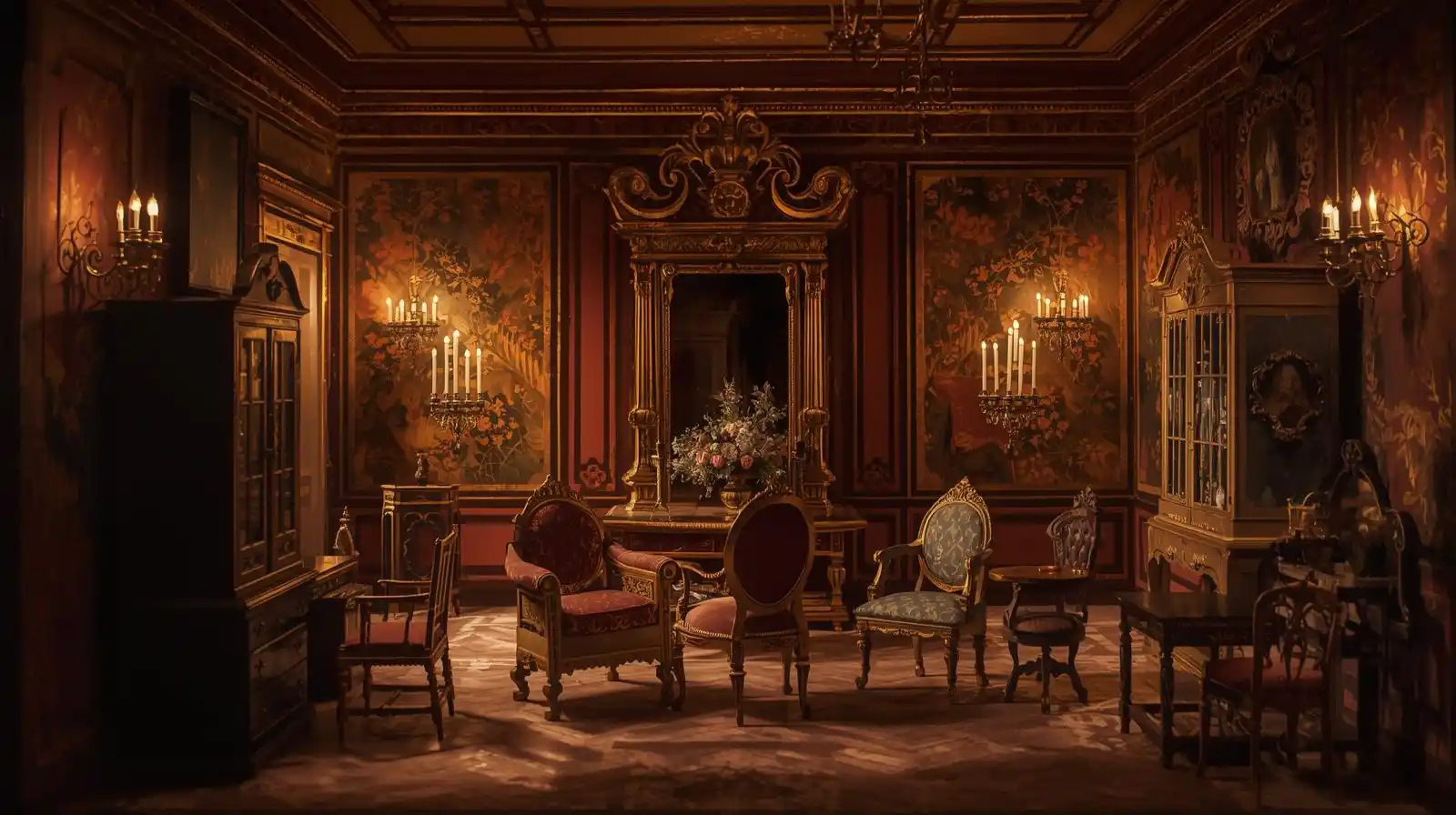Dollhouse furniture is much more than whimsical miniatures: for many hobbyists, collectors, and miniature crafters, it is the soul of a tiny interior. Whether furnishing a new build, restoring a vintage dollhouse, or dreaming up your own miniature world, this guide walks through everything from styles and materials to display, care, and collecting advice aimed at the adult miniaturist.
Scale, Proportions, and Practicalities
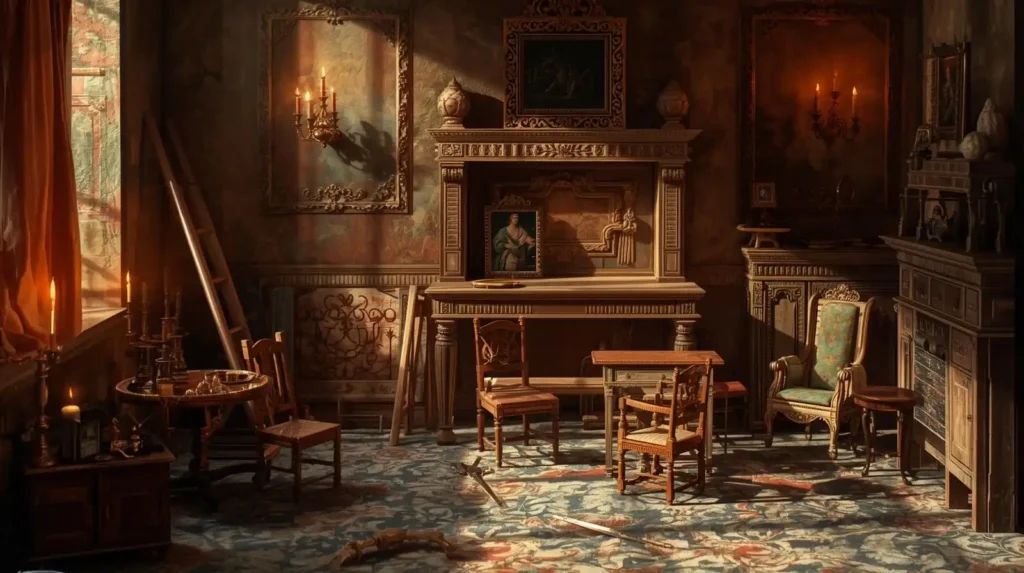
Before jumping into style or material, understanding scale is fundamental to successful miniature work.
- The most common scale among adult collectors is 1:12, sometimes called “one-inch scale,” where 1 foot in real life equals 1 inch in miniature. (Wikipedia)
- Other common scales include 1:24 (half-inch scale), 1:48 (quarter-inch), and even micro-scales like 1:144 for dollhouses within dollhouses.
- A mismatch in scale is one of the most obvious giveaways that something is “off” in a miniature scene. Always check dimensions, measure door heights, furniture legs, ceilings, and ensure consistency.
For many beginners, furnishing a single “room box” (a standalone miniature room for display) is a practical starting point. (A room box is essentially a self-contained miniature interior display box.) (Wikipedia)
Tip: When designing or buying furniture, sketch or mock up the room footprint in paper or on cardboard—this ensures the pieces will physically fit (and allow for human-scale “walking paths,” even in miniature).
Styles & Aesthetic Traditions in Dollhouse Furniture
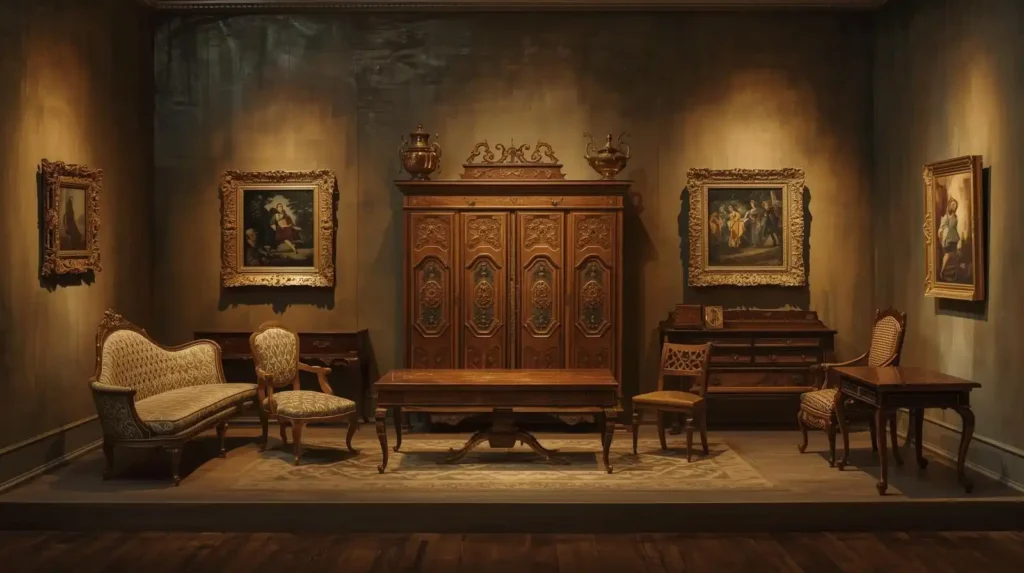
Dollhouse furniture inherits many of the design styles found in full-size furniture—though miniaturists sometimes favor certain eras. Below are some popular stylistic categories:
1. Victorian & Rococo Revival
Elegant curves, filigree carving, tufted upholstery, and ornate legs define this style. Because it is historically popular (late 19th century onward), many vintage dollhouse furniture sets and collector pieces reflect Victorian tastes.
This style lends itself well to “period” dollhouses—if you’re attempting to replicate a 19th-century parlor or drawing room, Victorian miniatures are often your go-to.
2. Georgian, Federal & Neoclassical
More restrained than Victorian, these styles emphasize straight lines, symmetry, classical columns, reeded legs, and modest ornament. Dollhouse furniture in this vein typically mimics the restraint of neoclassical full-size interiors.
3. Art Deco & Mid-Century Modern
For those building a mid-20th century or modern aesthetic miniature, Art Deco shapes, sunset curves, chrome details, and streamlined forms are favorites. These styles may appear in modern kits or more designer miniatures.
4. Country, Cottage & Rustic
Many miniature crafters prefer the cozy appeal of cottage, Shabby Chic, or rustic farmhouse styles—weathered paint, soft hues, distressed finishes, and natural wood tones. This style is forgiving, hides small irregularities, and works well in mixed collections.
5. Eclectic & Mixed Period
Experienced miniaturists often mix styles—pair a Victorian chest with a mid-century chair, or combine rustic and modern elements. The key is balance: unify with color, scale, or decorative accents so the mix feels intentional, not haphazard.
6. Specialized & Fantasy
Some dollhouse furniture leans into fantasy, steampunk, or themed settings (e.g. dollhouse for a wizard’s tower). In these contexts, proportion and coherence matter more than historical accuracy.
Materials & Construction Techniques
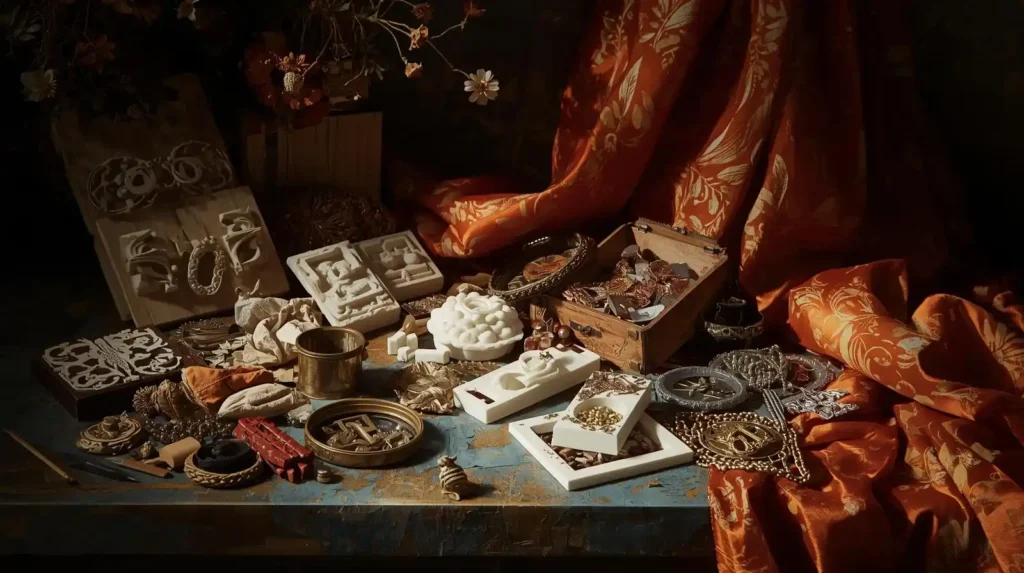
One of the joys (and challenges) of miniatures is choosing materials that translate well at a small scale. Here is a breakdown of common materials for dollhouse furniture, with pros, cons, and tips.
1. Wood & Wood Products
Balsa, basswood, and thin plywood are common — lightweight, easily cut and shaped, and friendly to glue and paint.
- Balsa is forgiving and easy to sand, but can be soft or dent easily.
- Basswood is harder and has nicer grain.
- Birch plywood in paper-thin sheets (1 mm to 3 mm) works for cabinet backs, shelves, or structural parts.
When using wood, precision matters—millimeter differences can throw off joints. Use sharp blades, clamps, and fine sandpaper.
Apply sealant or clear finish before upholstery or decoration to avoid moisture issues.
2. Resin, Polymer & Cast Materials
Many commercial miniatures are cast from resin or polymer. They allow fine detail (fluting, moldings, mini carvings) and are durable once cured.
- Pros: high detail, stable, replicable.
- Cons: often more brittle than wood, may need careful priming/painting, some fumes during casting.
Working with resin often involves silicone molds, mixing parts (resin + hardener), and attention to air bubbles or shrinkage.
3. Metal
Brass, pewter, copper, or sheet metal find use in railings, bed frames, legs, hardware, and accent pieces. Wire or engraved sheet metal can simulate cast iron or wrought iron in miniature.
Metal is more durable, but requires soldering, filing, and sometimes micro polishing.
4. Fabric, Upholstery & Soft Materials
Furniture upholstery is crucial to impart realism. Use ultra-thin fabrics (silk, cotton voile, chiffon) for seat covers, drapes, pillows. Foam, batting, and microfibers can simulate cushions.
Tip: Pre-wash and iron your fabrics in miniature scale to remove distortion. Attach using tiny stitches, glue dabs, or adhesives suited for fabric.
5. Paper, Cardstock & Composite Materials
Unexpected materials like cardstock, heavy paper, chipboard, or even cardboard are used especially in prototype or temporary pieces. They’re cheap and forgiving, perfect for testers or low-budget décor.
6. Mixed Media & Found Objects
Creative miniaturists often upcycle small beads, jewelry bits, wire mesh, toothpicks, matchsticks, or even seeds to detail furniture or accessories. This approach is central to DIY dollhouse furniture efforts and gives each miniature a unique character.
7. Finishes: Paint, Stain, Wax, Varnish
- Use thin, water-based paints (acrylics) in multiple light coats to avoid drips.
- Staining delicate woods must be done with tiny rags and diluted stains.
- Distressed finishes (sanding edges, dry brushing) are common for rustic or shabby-chic looks.
- Seal your finished piece with matte, satin, or gloss varnish to protect it—especially in display or handling.
Step-by-Step Building for Miniature Crafters

To help aspiring creators, here is a concise but effective DIY dollhouse furniture workflow:
- Sketch & Plan
Measure intended space, draw scaled elevations, note proportions and clearances. - Prototype / Template
Use cardstock or thin cardboard to mock up shapes. This reduces wasted material. - Cut Out Components
Using sharp blades, craft precise pieces for legs, arms, backs, tops, etc. - Dry-Fit & Adjust
Assemble with minimal adhesives to test fit. Sand, trim, or adjust as needed. - Glue & Clamp
Use fine wood glue or epoxy, employ micro clamps or weights until cured. - Fill & Sand
Use wood filler or putty to conceal seams; sand gently to smooth transitions. - Paint or Stain
Apply base coats, detail paints, distressing as desired. Multiple thin coats are better. - Apply Finishes & Detail
Seal, add hardware, upholstery, or embellishments like moldings or inlays. - Install & Stage
Place in the dollhouse or room box; add lighting, soft accessories, and life to the scene.
Throughout, work in a well-lit, dust-minimized space, and consider magnification (headband loupe or lighted magnifier) for fine detail.
Display, Maintenance & Preservation
Once furniture is installed, care and display planning matter:
- Cleaning & dusting: Use soft brushes, microfiber cloths, or gentle compressed air. Avoid over-dampening when dealing with wood.
- Humidity & Temperature: Maintain stable environment; extreme fluctuations can warp wood or crack finishes.
- Sunlight & UV: Prevent fading by avoiding direct sunlight or using UV-filtered glass in display cases.
- Handling & Repair: Transport pieces individually or padded; use archival storage if rotating collections.
- Lighting & Layout: LED lighting (low heat) enhances display but be cautious of heat on painted surfaces.
- Rotation & Rest: If some pieces receive light damage or stress, rotate them with stored backups.
Lightly dampened cloth for wood pieces and gentle methods (lint roller, cotton swabs) for fabric, always testing first.
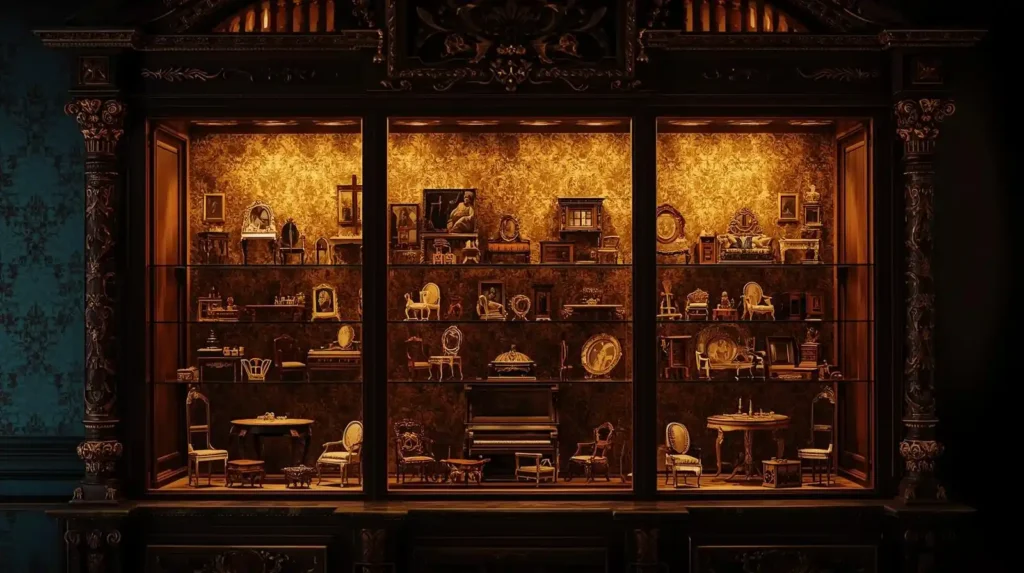
Collecting & Investing in Dollhouse Furniture
Beyond crafting, many enthusiasts become serious collectors. Here are key strategies and caveats:
1. Define Your Focus
Collectors often specialize—by period (Victorian, mid-century), maker, material, or size (1:12, 1:24, etc.). Narrowing focus helps build expertise and avoid duplication.
2. Authentication & Provenance
- Look for maker’s stamps, production marks, original packaging, or catalogs.
- Study auction catalogs or museum holdings.
- Beware of restorations or overpainting that might mislead value.
- Antique dollhouse furniture markets often reward provenance and originality.
3. Condition Grading & Value
- Condition matters immensely: warped legs, missing hardware, cracked veneers reduce value.
- Original finishes typically command higher prices than refinished ones.
- Even small chips or repairs can affect collectability.
- Price guides exist, and specialized miniature-collector auctions provide real-world benchmarks.
4. Storage & Insurance
Maintain secure, climate‐controlled storage (60–75 °F, ~40–50% humidity). Use padded boxes, separate layers, and silica gel packets. Photograph and catalog each piece for insurance and record.
Major museum-level dollhouses, such as the Astolat Dollhouse Castle, sometimes rotate interior miniature exhibits to reduce exposure to light and stress.
5. Marketplaces & Networking
- Auction houses with specialty toy or miniature lots
- Miniature fair conventions
- Collector groups, forums, and social media (e.g. Reddit’s dollhouse collector community) (Reddit)
- Specialized vintage dollhouse furniture dealers or flea markets
Networking with other collectors is invaluable: by sharing knowledge, spotting forgeries, and trading duplicates.
6. Restoration vs. Conservation
For vintage pieces, aim to conserve rather than forcibly restore. Gentle cleaning, minimal touch-up, and retaining original materials preserve value. Avoid heavy overpainting or replacing original parts unless documented.
Use Cases & Examples of Miniature Interiors

To ground these principles, here are some real-world miniature vignette examples and use cases:
1. The Victorian Parlor
Envision a 1:12 scale parlor: a tufted sofa, carved side table, upright piano, rug, gilt mirror, and trimmed drapes. By selecting a limited palette (white, gold, burgundy) and repeating motifs, the space feels cohesive despite multiple furniture styles.
2. The Modern Loft
A minimalist loft might include a sleek sofa, a cantilevered coffee table in acrylic, a mid-century sideboard, and abstract art miniatures. Metal legs and exposed structure lend a contemporary feel.
3. The Children’s Dollhouse/Nursery
Smaller dolls (1:24 or 1:48) lend themselves to compact furniture. Simpler forms, pastel colors, and whimsical details (toy chest, rocking horse) create charm without overcomplication.
4. A Collector’s Showcase Room Box
Instead of an entire dollhouse, some collectors build room boxes—a single interior scene in a container. This allows experimentation of lighting, mood, and display rotation.
Choosing the Best Dollhouse Furniture for Beginners
When starting out, novices often seek reliable, beginner-friendly pieces or kits to build skills and confidence. Here are traits of best dollhouse furniture for newcomers:
- Pre-cut, pre-finished kits reduce guesswork.
- Modular components or interlocking joints simplify assembly.
- Affordable price point—so mistakes don’t sting.
- Intermediate detail—not too plain, nor overly intricate.
- Accompanying instructions or tutorials for guidance.
Brands and starter kits that include clear instructions, spare parts, and compatibility with standard scales are ideal for building foundational skills.
Common Challenges & Tips from Miniaturists
Over decades, miniature crafters have honed workarounds. Some common pitfalls and fixes:
- Warping or bending: Use cross braces, seal both sides of wood, and store flat.
- Glue smudging: Use micro brushes, waxed paper under joints, or masking strips to catch excess.
- Paint bleed or muddiness: Mask areas, dry-brush details, and allow curing times between coats.
- Scale illusions: Slight exaggeration in texture or contrast often reads better in mini form.
- Lighting heat: Use LEDs and insulate against heat build-up near delicate painted pieces.
- Dust and fragility: Use a removable glass/acrylic front for display while allowing access for cleaning.
By learning from repeated trial and error, miniaturists build fluency in balancing ambition with patience.
Trends, Innovations & Where the Hobby Is Headed
The world of dollhouse miniatures evolves with technology and taste:
- 3D printing: Increasingly common for custom miniature furniture, especially one-off or complex shapes.
- Laser cutting: Allows precise templates and repeatable wooden parts.
- Digital kits & CAD files: Some creators sell digital blueprints for micro furniture.
- Designer miniatures & limited editions: Collectors commission stylized miniatures, pushing the hobby toward “miniature art.”
- Cross-disciplinary crossover: Miniature furniture appears in dioramas, wargaming terrain, architectural models, and even dollhouses for fashion dolls.
- Focus on sustainability: Some miniaturists explore reclaimed wood, eco-resins, and repurposed materials as materials become pricier.
Staying current involves reading miniature magazines, attending conventions, or joining online artisan groups.
Summary & Takeaways
- Always begin with scale—inconsistent proportions are the easiest flaw to spot.
- Choose a style (or mix) that suits your vision: Victorian, modern, cottage, etc.
- Select materials wisely: wood, resin, metal, or mixed forms each bring strengths and constraints.
- Follow a structured DIY dollhouse furniture process: prototype → cut → assemble → finish → detail.
- Care, display, and environmental control prolong the life and appeal of your miniatures.
- For serious collectors, focus, provenance, and condition are essential; avoid overrestoration.
- Start with modest, well-designed kits if you’re new—these are often the best dollhouse furniture for beginners.
- Learn from the community: experiment, iterate, and enjoy the process of bringing miniature worlds to life.
Whether your ambition is to furnish a complete dollhouse, curate a display of vintage dollhouse furniture, or build one-of-a-kind artisan pieces, the world of dollhouse furniture offers an endlessly rich and rewarding landscape.
Frequently Asked Questions (FAQ)
1. What scale should I choose for dollhouse furniture?
The scale you choose depends on the size of your dollhouse and your comfort working with small detail. For most adult-level dollhouses, 1:12 scale is standard and offers a broad selection of furniture and accessories. Smaller scales like 1:24 or 1:48 reduce cost and space but require more precision.
2. Can I mix furniture of different scales or styles in the same dollhouse?
Mixing styles (Victorian with modern, etc.) can work if unified by color, material, or design motifs. But avoid mixing scale—differences will be jarring unless very subtle. Always ensure legs, tops, and overall proportions align.
3. Is vintage dollhouse furniture always preferable to new kits?
Not always. Vintage pieces can carry charm, craftsmanship, and historical value, but they often need careful restoration and may have condition issues. New kits or artisan miniatures offer clean structure and ease of adaptation. For those interested in deeper collecting, see Vintage Dollhouse Furniture: A Collector’s Guide.
4. How should I store unused or spare miniature furniture safely?
Store pieces in padded, acid-free boxes, separated by tissue or foam sheets. Keep boxes flat to avoid bending. Use silica gel or moisture absorbers, and maintain a stable temperature/humidity environment to prevent warping or mold.
5. What adhesives are best for miniature furniture?
For wood, use fine-grain PVA wood glue or dilute white glue. For mixed materials, epoxy or cyanoacrylate (super glue) with micro applicators works well. Avoid excessive glue or drips that mar detail.
6. How do I clean or restore delicate miniature furniture?
Use soft brushes or microfiber cloths for dust. For wood, lightly damp cloth or diluted white vinegar applied with a swab may work (test first). For fabric, use a lint roller or gentle cotton swab. Always proceed slowly, testing in inconspicuous areas.
7. What are good first projects for someone new to miniatures?
Start with a single room box or a simple furniture kit—perhaps a chair, side table, or cabinet. These manageable pieces teach essential techniques and provide quick gratification. The best dollhouse furniture for beginners often comes in pre-cut, guided kits.
8. Where can I find inspiration or reference resources?
- Collector and miniature magazines or journals
- Auction catalogs or museum diorama booklets
- Specialty books, such as “The Dollhouse Decorator”
- Online forums, miniature conventions, or social media groups
- Visiting dollhouse exhibitions or major collections (e.g. Astolat Dollhouse Castle)

